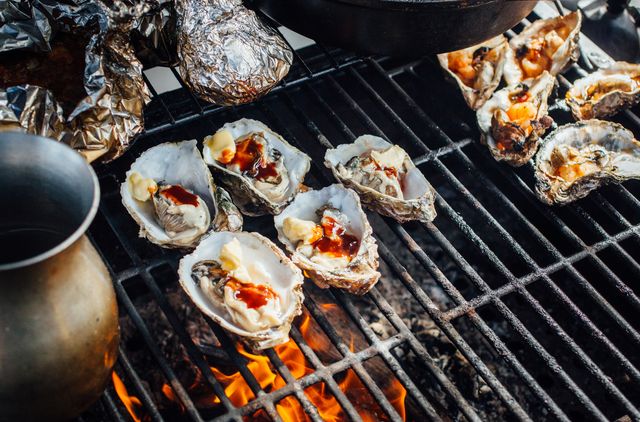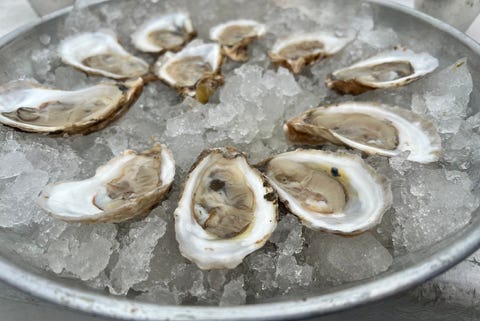Firing up the backyard grill in the summer is as American as apple pie. Who among us hasn't enjoyed a flame-kissed burger or dog on a hot July afternoon? But your grill's summer menu shouldn't be limited to patties and casings of ground beef; iconic and delicious as they are. You should mix it up once in a while by taking other foods for a spin on the grates. Namely, oysters.
So why — and how — should you be cooking shellfish on your grill? We spoke to an oyster expert to get the lowdown on barbecuing bivalves and why it's something you should be doing.
During a recent trip to Martha's Vineyard, I met Sims McCormick, the co-founder (with her husband, Rob Knecht) and CBO of Real Oyster Cult (ROC). ROC is a young Massachusetts-based online company that delivers fresh oysters (and suitable accouterments) to your door. "We thought it would be fun to create an online oyster bar and offer a wide selection just like you’d get when dining out at a fancy oyster bar," McCormick says of her reasoning behind founding the company. "Many people — especially those living in the middle of the country or in small towns — don’t have access to really fresh oysters and shellfish, so we now deliver it to doors across America."
The Benefits of Eating Oysters
I've always been a fan of oysters, and I've tried some of ROC's product — unsurprisingly, it's delicious. But I was surprised to learn from McCormick that oysters actually have a whole lot going for them besides their well-known flavor — particularly when it comes to the environment.
"You can feel extra good about eating oysters because they are a super-powered pro-environmental food. There are so many good things they do, like filtering nitrogen and sequestering carbon in their shells," McCormick says. "They act as the literal bedrock for ecosystems and actually help fight climate change."
"There are no inputs to farming oysters," McCormick says. "Unlike land farming or fish farming, they don’t require feed or fertilizers. They eat what’s in the water and actually make it cleaner. Then they filter it all out."
In case the knowledge that oysters are literally saving the world by building reefs that protect coastal cities from rising sea levels and naturally capturing carbon — a Sea Grant study estimates that Americans replacing 10 percent of their meat intake with oysters would equal the carbon emissions reduction of removing 11 million cars from the road — isn't enough to get you on board the oyster boat, McCormick adds that the tasty mollusks are also fun to eat and very good for you.
"Oysters are a social food, they really bring people together," McCormick says. "It’s not just an appetizer or a delicacy, it’s an activity and a ritual. Shucking and sampling different types of oysters is fun and often a learning experience.
"And they are nutritious. Gram for gram, an oyster is one of the most nutrient-rich foods on the planet. It’s basically like enjoying a tasty supplement from the sea!"
How to Grill Oysters
OK, with oyster school out of session, it's time to fire up the grill. As fun as shucking can be, not everyone wants to bother with doing it. And not everyone is a fan of eating raw oysters, which are technically alive when you send them down your gullet. So grilling them is a great alternative.
"Grilling oysters is actually extremely easy," McCormick says. "Anyone can do it, and you don’t have to shuck them! The heat does all the work."
Before you pop your shells on the grill, McCormick recommends whipping up a simple topper for your grilled oysters by combining the following ingredients.
- 1 – 2 sticks of butter
- 2 Tbsp chives
- 1 clove minced garlic
- 1 Tbsp shallot
- 1⁄4 cup grated parmesan cheese
Next, you'll want to place your unshucked oysters cup-side up (that's the rounded side) on a hot grill. After a few minutes, the heat will force the top shell to gently pop open. As your oysters open, use tongs to remove them from the grill and pry off the top shell, leaving the oyster exposed. At this point, brush your topper mixture onto the oysters and place them back onto the grill for a couple more minutes until they start sizzling. Then it's time to remove the oysters from the grill one last time to eat and enjoy them.
How to Shuck Oysters
To truly experience oysters, I — and Sims backs me up here — also recommend eating at least some of them raw in addition to grilling them. The ROC founder is right when she says that shucking and eating raw oysters is an experience, and it's pretty easy too — I learned how to do it in about two minutes. First, you'll need two pieces of equipment: some shucking gloves and an oyster knife.
"We prefer an oyster knife that has a sharp tip, simply because it’s much easier to pry open the hinge with a sharper, skinnier tip," McCormick says. "And you should always wear gloves or wrap your hand in a towel to be safe."
These gloves feature a gritty nitrile-coated palm that will both protect your hand from cuts and keep you from losing your grip on wet, slippery oysters.
Made In's take on an oyster knife features a narrow and very sharp blade crafted from 420HC high-carbon stainless steel and an easy-to-grip walnut handle.
Shucking Instructions
- After putting on your gloves, hold the oyster cup-side down in your non-dominant hand. Take the oyster knife and insert it at the hinge — the small opening, sometimes just a crack, at the narrow end of the oyster where the two shells meet.
- Once your blade is in the hinge a little ways, begin to wriggle it from side to side. The shell will pop open.
- With the shell open, run your blade along the "ceiling" of the oyster to cut the adductor muscle holding the top shell to the oyster. Remove the top shell.
- Finally, use your knife to disconnect the muscle joining the oyster's flesh to the bottom shell.
- Shoot back your oyster — and be sure to chew to get all the flavor — and discard the shells ... preferably into the ocean where it can start a new reef.
























